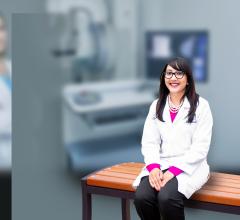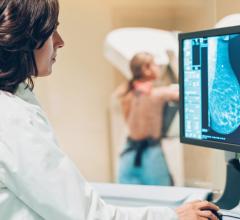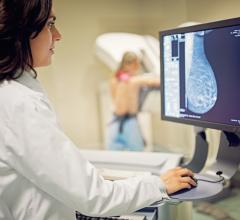As with any imaging modality, breast MR is known to have some limitations. Ironically, the very thing that makes MR attractive – its high level of detail – reveals myriad structures not visible on X-ray film, many of which befuddle even the most astute radiologists.
Put another way, many MR machines don’t approach the level of specificity that other modalities do. This has led to concerns that MRI, just like mammography, may produce unacceptable false-positive and false-negative readings, according to the American Cancer Society (ACS). Such limitations have contributed to higher-than-expected rates of callbacks and biopsies to rule out suspicious findings, and rash decisions by women to have bilateral mastectomies when anything of a suspicious nature is found. This is precisely why the ACS shies away from recommending breast MR in women whose cancer risk is deemed to be relatively low. The ACS and other observers note, however, that breast MR callback and biopsy rates drop significantly when follow-up scans are performed.
“The major advantage of breast MRI is its high negative predictive value (unique for breast imaging methods),” said Steven Harms, M.D., a radiologist at The Breast Center of Northwest Arkansas and medical director of Aurora Imaging Technology Inc. “In other words, if the opposite breast or other regions of the breast are cleared, then more targeted therapy can be performed. The ultimate goal is to define therapy to the patient’s actual disease rather than on projections of possible disease based upon statistical analysis as has been done in the past.” Dr. Harms added that be believes more clinician experience and better technology will soon make MRI “significantly better than mammography” in terms of positive biopsy rates and call-back rates.
Still, the advantages of breast MR are far more compelling:
• Put simply, any technology that allows doctors to catch more cancer is a good thing. Breast MR typically finds smaller tumors much earlier than mammography and other modalities. It also can spot increased or abnormal blood flow in the breast, a sign of early cancers not visible on mammogram, according to the ACS.
• Imaging centers that employ bilateral breast coils can image both breasts simultaneously, allowing tumors to be spotted sooner.
• Breast MR is safer than mammography because it produces no ionizing radiation.
• Patient comfort is a big factor. Unlike compression with mammography, breasts fall into soft coils.
Recent innovations
The quality of breast MR scans is highly dependent on a variety of factors, including signal-to-noise ratios and high spatial resolution with high field magnets producing thin slices and high matrices (approximately 1 mm in-plane resolution), according to the ACS. Recent innovations have included MR elastography (which combines sound waves and MRI to evaluate the mechanical properties of breast tissues), combining various types of MR imaging techniques such as T1, T2 and 3-D imaging techniques, chemical markers detected by proton magnetic resonance spectroscopic imaging (MRSI) and a variety of ancillary nonmetallic products that are MR safe.
Open bore systems are becoming more popular than conventional tunnel systems because they better facilitate procedures like MR-guided biopsies, and more easily accommodate patients who are claustrophobic, elderly or obese.
For example, GE Healthcare incorporates a detachable, movable procedure table in its Signa HD scanners. The open architecture design of the Vanguard table, manufactured by Sentinelle Medical Inc., provides complete medial and lateral access to the breast, giving clinicians unimpeded access.
About 30 percent of all MR scans are performed on obese patients, one of the motivations behind Siemens Medical Solutions’ Espree, an open bore machine that includes a 70-centimeter-wide bore to accommodate heavy and claustrophobic patients with its “head-out, feet first” features, said Nealie Hartman, marketing manager, Women’s Health, MR Division at Siemens Medical.
To accommodate the lack of skilled technicians in many MR suites, system manufacturers have invested a great deal of R&D in information technology in efforts to make breast MR procedures what GE Healthcare’s general manager, Global MR Product Marketing, David Handler calls “push- button simple.”
“When breast MR came into use, it was fairly difficult to perform for physicians,” Handler said. “Our focus has been on an entire solution to make it easier to perform, increase the speed and improve the quality.”
Better MR imaging protocols (such as parallel imaging), biopsy devices and workstations are the key areas where innovation has dominated in recent years, according to Michelle Macpherson, Sentinelle Medical spokesperson. Development of breast coils with higher numbers of channels with either fixed or variable geometries also are giving clinicians the ability to modify the coil placement based on the size of the patient’s breasts.
Digital imaging and advanced workstations also are bolstering the ability of clinicians to more accurately interpret such large volumes of data, Macpherson continued. “Radiologists want to be confident in the decisions they make about the management of the patient and they want to be able to do this efficiently,” she said. “With the advent of digital imaging, there are powerful workstations for viewing patient data of all imaging modalities so the radiologist can now review the patient’s ultrasound, mammogram and MRI all at the same time. These are advanced systems that are significantly faster and more user friendly than they were just a few years ago.”
Here’s a look at some recent innovations from major MRI vendors:
• Aurora Imaging – Aurora’s 1.5T Dedicated Breast MRI system with Bilateral 3-D SpiralRODEO is the first and only FDA-cleared, fully integrated MRI system designed specifically for breast imaging. Aurora’s exclusive precision gradient coil design provides an elliptical “sweet spot” that images both breasts, chest wall, and axillae in a single bilateral scan without compromising image contrast or resolution. The SpiralRODEO uses an innovative method for suppressing normal ductal tissue signal allowing tumors to be visualized in women with radiographically dense breasts. Dr. Harms said the system, which delivers about three times the signal of conventional MRI acquisitions, provides significantly higher resolution and integrated biopsy capability.
• GE Healthcare – The company’s breast MR platform, VIBRANT, images both breasts simultaneously with an eight-channel coil and includes a high definition version that expands the capability to acquire high-resolution images at high speed, “providing both exceptional anatomical detail and critical kinetic information,” said Handler. GE’s MR BREASE, a dedicated, breast-specific spectroscopy package, can help improve the ability to characterize benign breast lesions by showing differentiated concentrations of choline. “When GE developed VIBRANT, we changed the game in terms of the difficulty in acquiring data,” said Chris Fitzpatrick, MR clinical marketing program manager. Before VIBRANT was introduced, two different exams were needed at different times for each breast, he added.
• Siemens Medical Solutions – Nancy Gillen, group vice president of MR, said the company’s MAGNETOM MR scanners feature a bilateral CP Breast Array Coil that offers high resolution, and excellent tissue contrast and image quality. Siemens’ Total Imaging Matrix (TIM) is a RF/coil technology that allows high temporal resolution, ease of use and improved throughput, she added.
• Toshiba America Medical Systems – The company’s Vantage scanners allow women to enter the magnet feet first instead of head first, a big plus for patients who are fearful of the confined spaces of conventional tunnel systems. Bob Giegerich, director of the company’s MR business unit, said Toshiba also offers the quietest magnets on the market today, with a 98 percent reduction in noise thanks to its Pianissimo technology, which places the gradient in a vacuum. Other Toshiba innovations include “fat-free imaging,” which uses proprietary software to eliminate signals from breast fat, and contrast-free imaging techniques that can perform MRA, fresh blood imaging, contrast-free improved angiography and Time-SLIP.
© Copyright Wainscot Media. All Rights Reserved.
Subscribe Now


 July 24, 2024
July 24, 2024 








